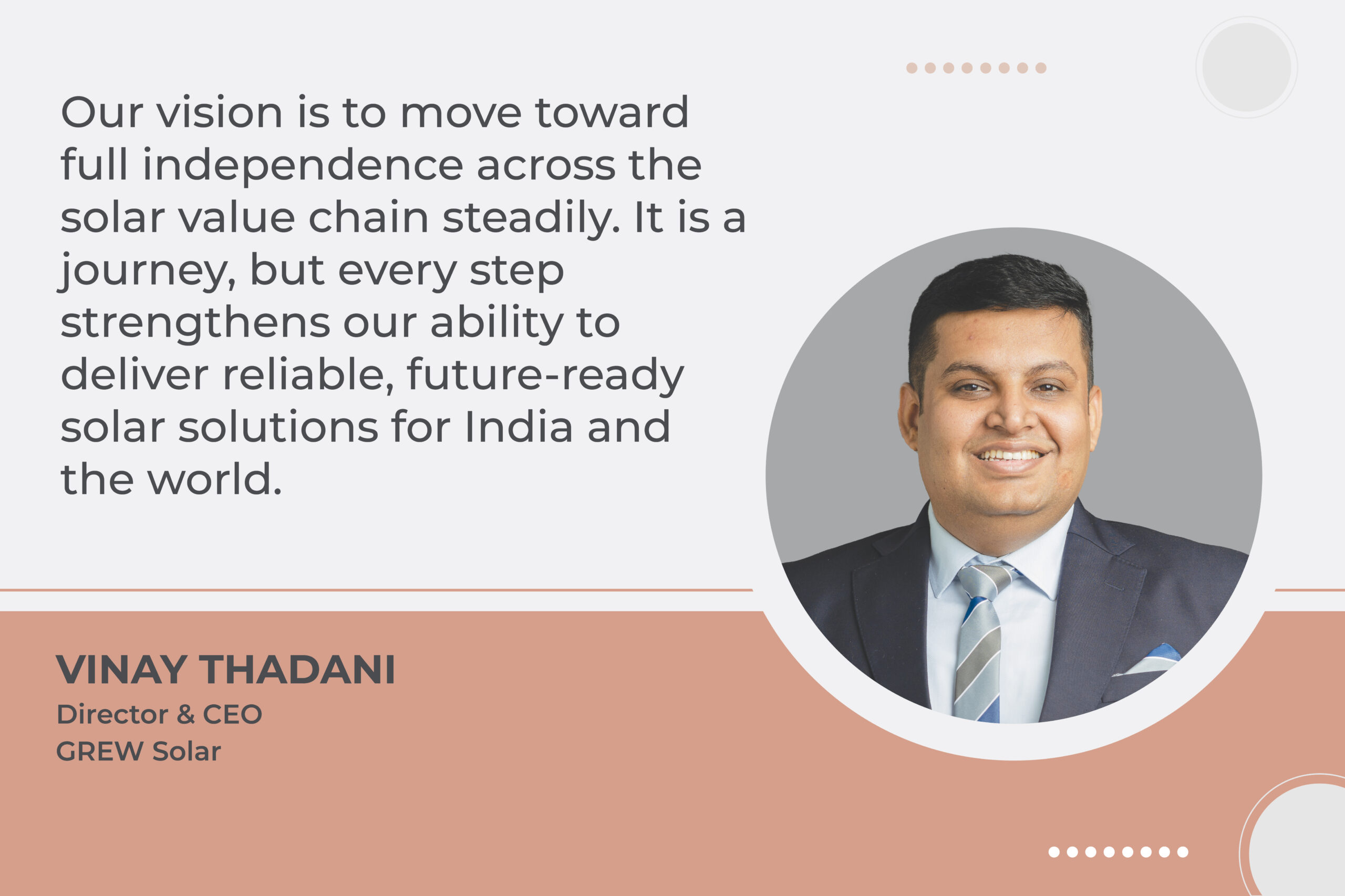GREW Solar to invest ₹3,000 crore to accelerate solar self-reliance
By Staff Report September 25, 2025 7:30 pm IST
By Staff Report September 25, 2025 7:30 pm IST

The company’s 11GW module expansion and ₹3,000+ crore investment in a 8GW TOPCon solar cell facility at Narmadapuram in Madhya Pradesh mark a decisive step toward solar manufacturing self-reliance.
True self-reliance, mastering wafers, cells, modules and not just assembling panels, is required for building a strong solar future in India. GREW Solar is at the forefront of this transformation with 11 GW PV module capacity by 2026 and a ₹3,000+ crore 8 GW solar cell facility. Vinay Thadani shares that the company is strengthening domestic supply chains, creating jobs and advancing global solar leadership. Learn more from him.
How can India overcome supply-chain challenges to achieve full solar manufacturing self-reliance?
Self-reliance in solar manufacturing goes far beyond assembling panels. It requires building an end-to-end ecosystem, spanning ingots and wafers, high-efficiency cells and advanced modules. By true independence, we mean mastering every stage of the value chain, reducing external dependencies and driving innovation from within.
At GREW Solar, we see this as both a responsibility and an opportunity. Our expansion to 11GW solar PV Module manufacturing capacity at Dudu Rajasthan by 2026 and our upcoming ₹3,000+ crore investment in a 8 GW PV solar cell manufacturing facility at Narmadapuram, Madhya Pradesh, mark a decisive stride toward this vision. Spanning 60 acres, the plant aims to a three-stage backward integration design and is equipped with state-ofthe- art TOPCon solar cell technology. Beyond technological advancement, it will create more than 1,000+ new jobs, bolster domestic supply chains and reinforce India’s position as a rising leader in the global solar landscape.
Of course, the journey to complete supply-chain independence is not without challenges, but with strategic investments, consistent innovation, and robust policy support, these gaps can and will be closed. The momentum is undeniable: facilities like ours stand as proof that India is no longer just catching up. We are laying the foundation to lead the future of solar manufacturing worldwide.
How can automation and AI in solar manufacturing drive higher efficiency and reliability while positioning India as a global leader? And how is your company mitigating risks around raw material imports?
Automation and AI are reshaping solar module manufacturing by making production smarter, faster and more reliable. At GREW Solar, automation ensures precision and speed at every stage. At the same time, AI goes a step further by detecting even the smallest quality issues in real time and predicting machine maintenance before downtime occurs. Our manufacturing plant is designed for Industry 4.0, where robotics, AI and advanced automation come together to deliver precision engineering, strict quality control and minimal waste. This integration does more than improve efficiency; it builds trust through consistent performance, enhances sustainability and ensures that our solar solutions are truly futureready.
The global solar supply chain has seen major disruptions, and our response is to build resilience from within. We have invested heavily in our in-house R&D to drive innovation and efficiency, and are also moving into backward integration. By aiming to develop critical components like cells, we are reducing dependency on imports and securing our supply chain. Our vision is to move toward full independence across the solar value chain steadily. It is a journey, but every step strengthens our ability to deliver reliable, future-ready solar solutions for India and the world.
Do Grew Solar foresee India evolving into not just a manufacturing hub for modules but also upstream components like wafers and cells?Yes, India is well on its way to becoming not just a hub for solar modules but also for upstream components like wafers and cells. With strong government support through the PLI scheme, the ecosystem is clearly moving in favour of domestic manufacturing. GREW currently operates 3 GW of PV module capacity in Rajasthan, with 8 GW of cell capacity planned in Narmadapuram, Madhya Pradesh, as part of its roadmap to 11 GW by 2027. Backed by strong R&D, advanced automation and the 52-year legacy of the Chiripal Group, GREW is advancing India’s clean energy ambitions. This strengthens our supply chain, reduces reliance on imports and creates new opportunities across the value chain. The path to full self-reliance for India is clear, and we are proud to be building that future.
How will India balance utility-scale growth and rooftop adoption to shape solar manufacturing demand?
Both utility-scale projects and rooftop adoption will drive the solar growth story of the country in the coming years. Large solar farms are expanding quickly as businesses and developers move to meet rising energy demand cost-effectively. Rooftop solar is picking up more gradually, shaped by government support and growing awareness, though financing and infrastructure remain limiting factors. For manufacturers like us, this means scaling capacity for large utility projects while also innovating smaller, high-efficiency modules for rooftops. Both segments are critical, and together they will define how solar manufacturing demand evolves over the next five years.
What technologies or offerings are you putting forward at REI 2025?
We will be launching the G12R TOPCon High-Power Modules and showcasing the M10 TOPCon Modules with 30-years warranties at the upcoming Renewable Energy India Expo (REI 2025).
We use cookies to personalize your experience. By continuing to visit this website you agree to our Terms & Conditions, Privacy Policy and Cookie Policy.